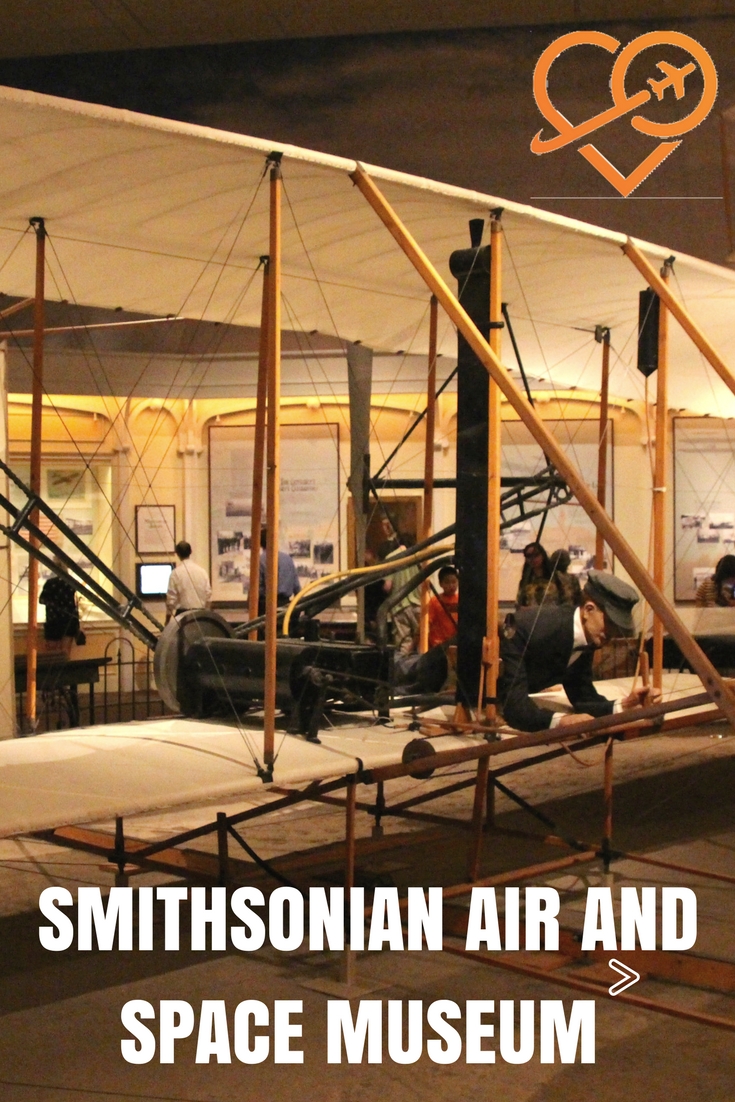
Spirit of Saint Louis – Smithsonian’s National Air and Space Museum
I love airplanes and space travel, so I love the Smithsonian’s National Air and Space in Washington D.C. When City Wonders offered that I could take a semi-private tour of Air and Space while I was in Washington D.C. last week (in exchange for this blog post) I jumped at the chance.
The Smithsonian Air and Space Museum is huge. You can easily spend an entire day there even without visiting the Udvar Hazy extension of the museum out by the Dulles airport. The City Wonders tour is two and a half hours long and is intended to provide a great overview of the museum. Our guide, Craig Steinberg, has been a guide at Air and Space for years and was knowledgeable not just about the specific exhibits of the museum but how to put them in a larger perspective.

Write Brother’s Flyer – Smithsonian’s National Air and Space Museum
Wright Brothers Flyer
We started at the exhibit about the Wright Brothers Flyer. Like most of the items displayed at the museum, this is the original plane that Orville and Wilber used to demonstrate the possibility of heavier than air flight. This model never flew more than 200 feet. Craig explained that the Wright brothers had three different problems that they needed to solve:
- They needed to figure the correct shape for the wing to get lift
- They needed to find or build an engine with sufficient power but that was light enough and small enough to fit on their flyer
- They needed to invent a way to steer their plane
The brothers attacked each of the problems in turn. To determine the correct shape for the wings they started with previous designs from other inventors. They first flew the designs as kites and then invented the wind tunnel which helped them find the flaws in the previous designs and create a wing shape that would work.
They tried to outsource the problem of the engine but although an 8 horsepower engine may seem puny to us, a light engine with that power was not available so they needed to invent it.
They created 3 different mechanisms to steer their craft. They controlled the pitch of the craft with an elevator on the front of the plane. They controlled the yaw of the plane with a rudder on the back which is the most familiar of their control surfaces. To control the plane’s roll they invented a mechanism to warp the shape of the wings that was attached to a device that the pilot controlled by moving his hips. Pilots everywhere should be glad that better controls were eventually invented because this was not an easy plane to fly. Because the flyer is no longer hung in the lobby, you can see more of these devices and this exhibit, along with Craig’s commentary, helped me gain a new appreciation for these bicycle mechanics from Ohio. We had only done one exhibit and I was already loving the tour.

X1 & Airship One – Smithsonian’s National Air and Space Museum
Other Historic Airplanes
In the main lobby of the museum, you can see additional record-setting craft like:
- The Spirit of Saint Louis – The plane that Charles Lindbergh piloted solo across the Atlantic. As Craig pointed out, the plane has no windshield… really. It does have a periscope that Lindberg could use to peer out the side to see his forward progress. Lindberg exchanged the windshield for an extra fuel tank since he thought the odds of meeting another plane coming the other way across the Atlantic was pretty small.
- The Bell X1 – If you saw “The Right Stuff” you may recall test pilot Chuck Yeager breaking the sound barrier in this jet-powered airplane.
- The X15 – The fastest rocket-powered aircraft, this craft flew more than 6x the speed of sound.
- SpaceShipOne – This craft one the X prize for the first commercial craft to fly to the edge of space and back twice in the span of a week.

John Glenn’s Mercury capsule – Smithsonian’s National Air and Space Museum
Historic Spacecraft
- Apollo 11 Command Module – To see the only other surviving portion of Apollo 11 you would have to travel to Tranquility Bay on the moon. I recall watching the Apollo 11 astronauts walk on the moon from vacation while at a trailer park in Victoria British Columbia.
- John Glenn’s Mercury Capsule – It wasn’t clear if Glenn’s trip was going to be a one-way trip or a return one when a warning light lit up in mission control that indicated his heat shield might be damaged. As Craig told us, the problem turned out to be a not with the craft but with the warning light.

WWI Folker Triplane – Smithsonian’s National Air and Space Museum
WWI and WWII
We toured the WWI and WWII exhibits to see how planes like the Wright Brother’s flyer became more and more sophisticated and more and more deadly in a relatively short period of time.
Commercial Air Travel
We heard about the origins of commercial air travel in the U.S. which the federal government was able to bootstrap with the invention of airmail.

Apollo Lunar Excursion Module – Smithsonian’s National Air and Space Museum
Updates
The Air and Space Museum in Washington, DC, is currently undergoing a large-scale renovation that will result in completely new galleries and public spaces. Also, some of the aircraft like the LM-2 and John Glenn’s capsule have been moved from the positions pictured above.
-
- The Apollo 11 Command Module Columbia is currently on display at the Steven F. Udvar-Hazy Center. Columbia will return to the Museum in Washington, DC, in 2022, as part of the upcoming “Destination Moon” exhibit.
- The World War I and World War II galleries are both closed for the renovation. You can get your fix at the Steven F. Udvar-Hazy Center though.
- The museum has a larger collection than they have space to display. Amelia Earhart’s Lockheed Vega is currently off view.
Conclusion
Throw in an airmail plane flown by Eddie Rickenbacker (America’s number one WW1 ace), Amelia Earhart’s record-breaking plane, a replica of Skylab and Apollo-Soyuz, and an original Apollo Lunar Excursion Module and the Air and Space is an amazing and somewhat overwhelming museum.
Even with a City Wonder’s guide to put things in context and tell so many of the backstories a two and a half hour tour of the Air and Space Museum is too short to see everything, but… it is a pretty great start!
The Air and Space Museum also has a second location near the Dulles Airport: National Air and Space Museum’s Steven F. Udvar-Hazy Center.
+Chris Christensen | @chris2x | facebook
Leave a Reply
Tags: article, museum, smithsonian, washington d.c.


 Things to do Near Dulles Airport – Steven F. Udvar-Hazy Center National Air and Space Museum
Things to do Near Dulles Airport – Steven F. Udvar-Hazy Center National Air and Space Museum Washington D.C. – Episode 50
Washington D.C. – Episode 50 Best Museums in Washington, D.C., With Exhibits Worth Visiting
Best Museums in Washington, D.C., With Exhibits Worth Visiting Seattle 3 Day Itinerary – More than just the Space Needle
Seattle 3 Day Itinerary – More than just the Space Needle
